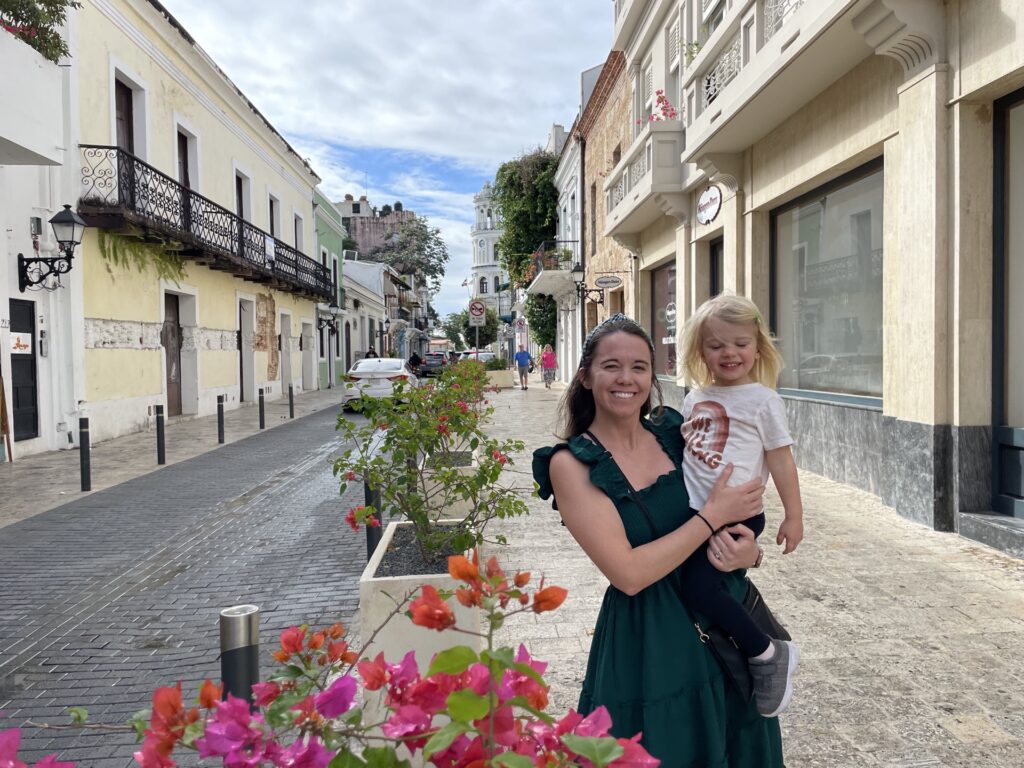We recently spent a long weekend in Santo Domingo, Dominican Republic. The city is jam packed with history, as you would expect from the oldest continuously inhabited European settlement in the Americas. In this post, we share what Santo Domingo is like, what there is to do there, and how you can plan a perfect trip to this Caribbean capital. Read on to learn more about planning a trip to Santo Domingo!
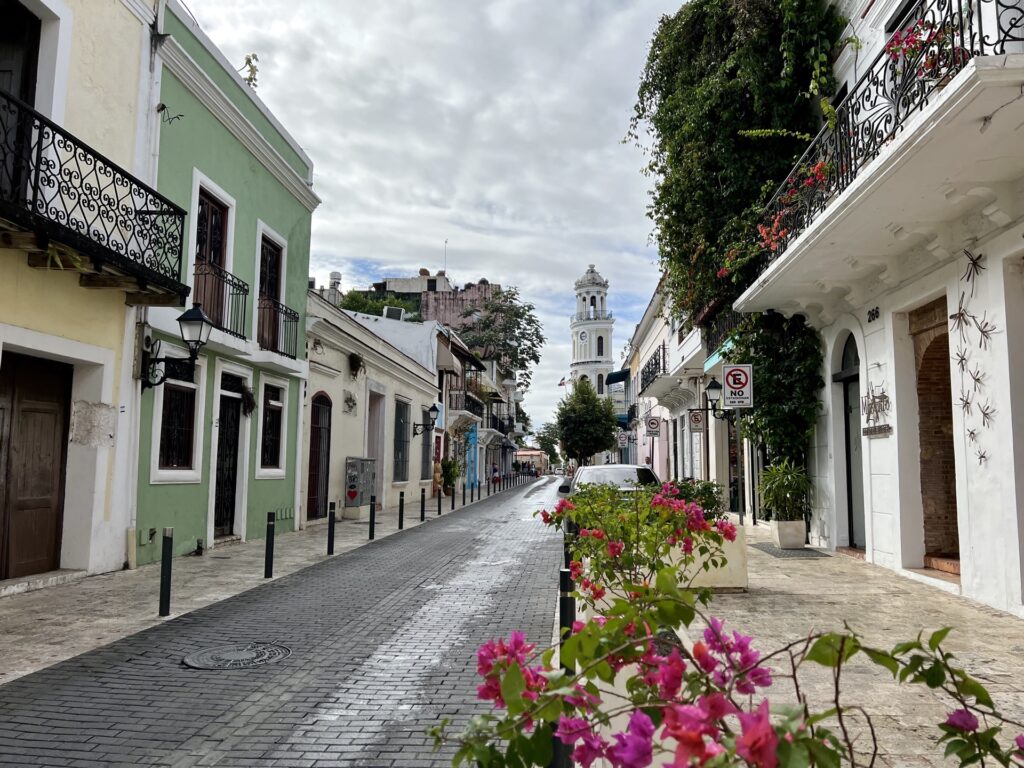
In this post
Here’s what we’re covering in this post. We invite you to read the full guide or jump ahead to the section you’re most interested in.
- About Santo Domingo
- Planning a trip to Santo Domingo
- Things to do in Santo Domingo
- 2-day Santo Domingo Itinerary
About Santo Domingo
Santo Domingo is the capital city of the Dominican Republic. It’s located on the south side of Hispaniola, the island shared by the Dominican Republic and Haiti.
Santo Domingo was the first European settlement in the Americas. Christopher Columbus landed on the island in 1492, and it was colonized by the Spanish shortly after. His son Diego arrived as Viceroy in 1509 and built the first European palace and military construction in the Americas.
Santo Domingo was strategically built on a grid, with roads running parallel to each other and crossing at perpendicular intersections. This grid system would become the model for most future cities in the New World. Many cities today continue to use the grid system (including Chicago as a famous example).
Later, in the 1700-1800s, the city changed hands from Spain to France to Haiti. The Dominican Republic achieved independence in 1844 and Santo Domingo named the capital city.
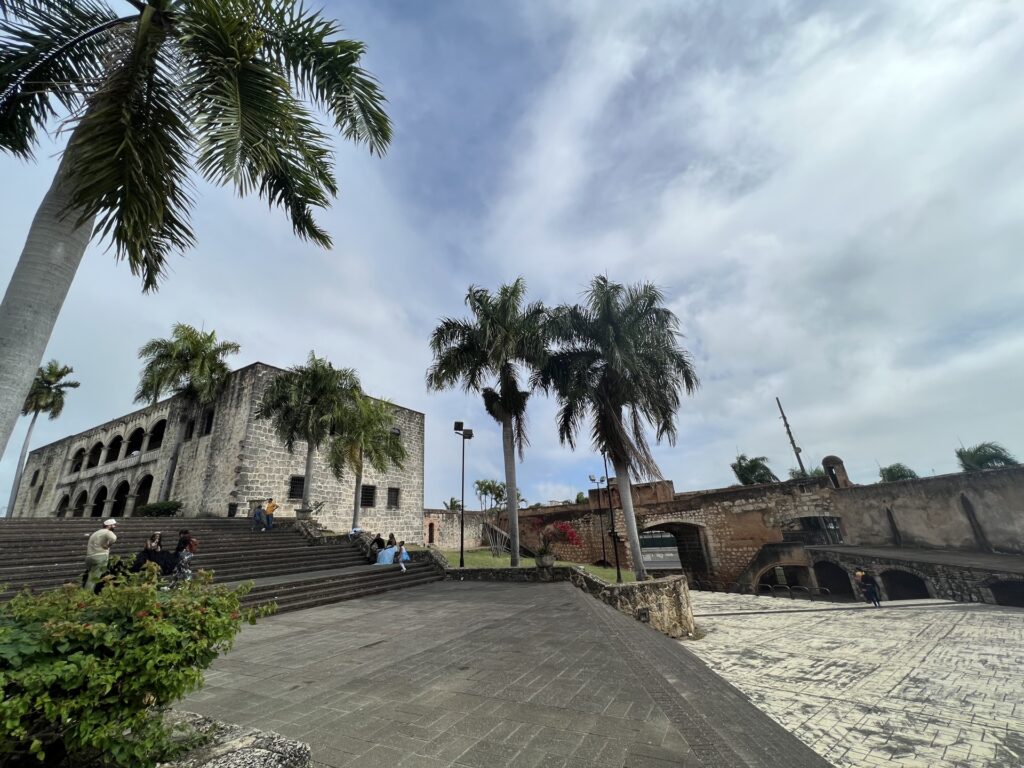
The central district of Santo Domingo, which was once protected by the Walls of Santo Domingo, is now called Zona Colonial. It has been a protected UNESCO World Heritage Site since 1990.
Zona Colonial is the main tourist district in Santo Domingo. In addition to many historical sites and museums, the area is also now home to modern comforts like bars, restaurants and coffee shops.
The city extends far beyond Zona Colonial, though, with a metro area population of over 3 million people.
What is it like to visit Santo Domingo? (Zona Colonial specifically)
Santo Domingo is a Spanish Colonial town filled with history and culture. A trip to Santo Domingo will be spent walking past centuries-old buildings, popping into many different small museums and people watching in lively squares. It is a historic, city destination, not to be confused with the sandy beaches of nearby resort towns like Punta Cana.
Zona Colonial — the historical district — feels vibrant but lived in. There are colorful buildings dripping with bougainvillea, but mixed in with that are crumbling apartment buildings and hole-in-the-wall bodegas. You’ll see the beautifully preserved sections of the city walls at Ozama Fortress, but then you’ll walk along the city wall at Plaza de la Hispanida and mostly find broken beer bottles. That dichotomy creates the feeling of a city that has grit and charm all at once.
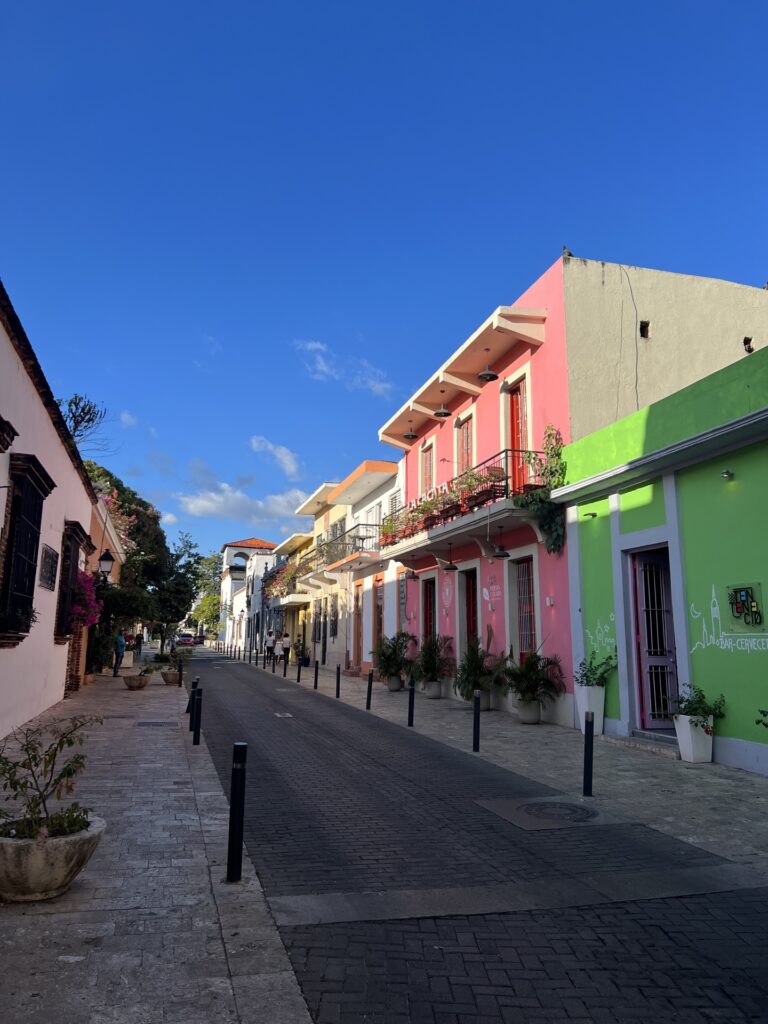
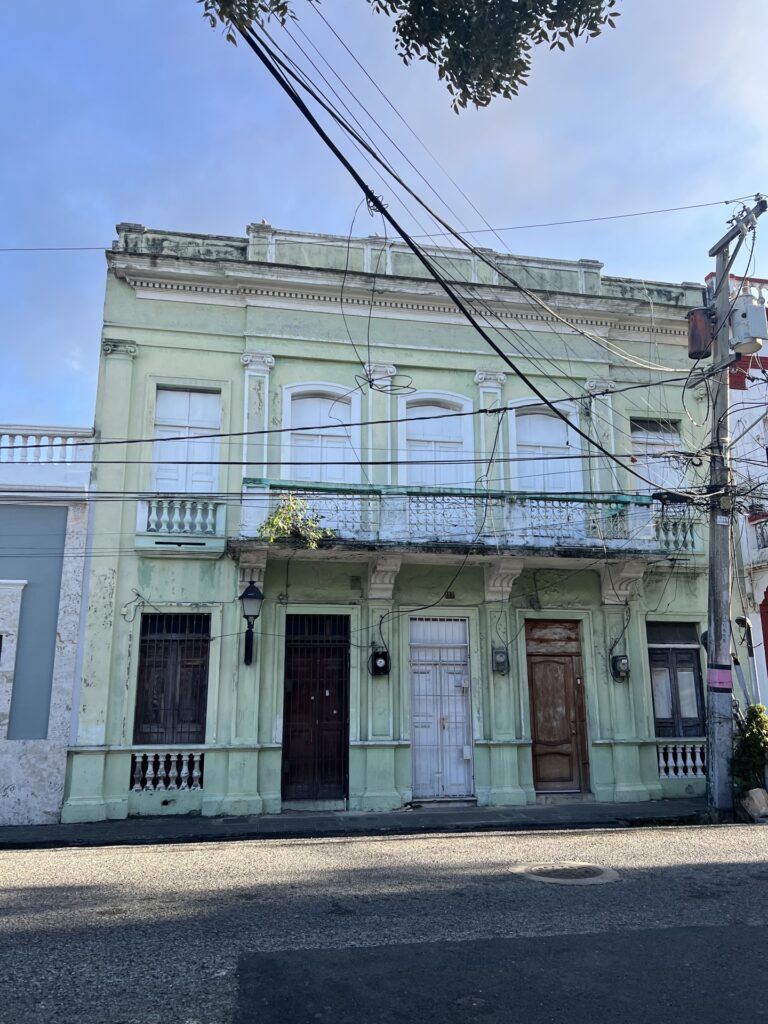
While Zona Colonial is not as manicured as Cartagena’s old town, that’s where my mind went for comparison. Both are formerly walled cities with similar architecture and culture. The energy, lifestyle and even weather felt similar in both places.
As you walk down the bumpy sidewalks, you’ll see locals sitting in lawn chairs on sidewalks outside their homes or corner markets, drinking beer and listening to loud music. The parks and squares are filled with kids chasing pigeons, sales people hawking light up toys and guitar players trying to entertain diners for tips.
There’s a palpable easiness about Santo Domingo — a lack of hustle that I admire. We’re from New York, where it feels like people are always trying to get somewhere. But in Santo Domingo, it feels like everyone — tourists and locals — are enjoying where they are.
There is also very little English in Santo Domingo. Our hotel staff spoke English, but nearly everyone else we talked to did not. Most signs and menus were only in Spanish. If you do speak Spanish, the Spanish spoken in Santo Domingo is quite different than other Spanish dialects.
Planning a trip to Santo Domingo
Let’s jump into planning at trip to Santo Domingo. Here’s the practical information you’ll need to know to book your trip.
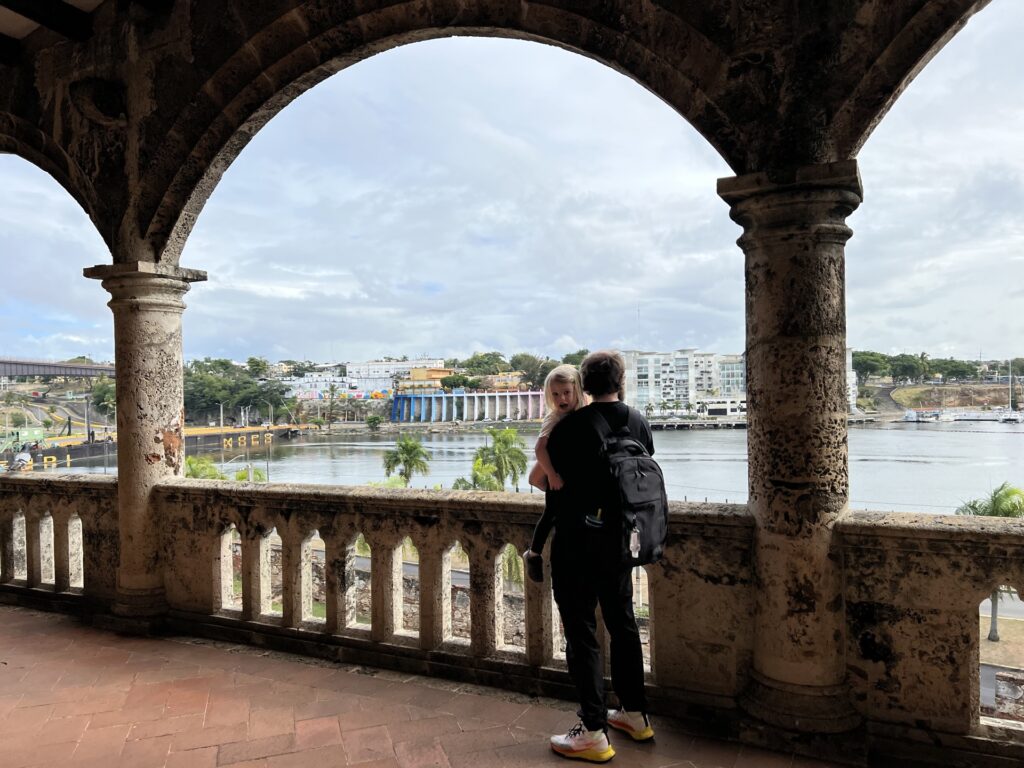
Visa Requirements
Travelers from most countries (including the US, Canada, Great Britain and the EU) do not require a visa for visits less than 30 days. All that is required is a valid passport and a “Tourist Card,” which is essentially a $10 fee that will most likely be tacked onto your airfare.
In addition to the Tourist Card, all visitors (regardless of age) will need an eTicket. The eTicket is a digital form that you fill out online before your trip. (You can find more information and a link to the form here.)
Once you submit the completed form, you will immediately receive a QR code. You should be prepared to display your QR code when you enter and leave the country. In our experience, we were only asked to show the code one time in the US before we boarded our flight to Santo Domingo.
How to get to Santo Domingo
To get to Santo Domingo, you will need to fly to Las Américas International Airport (SDQ). The airport serves around 30 different international airlines, including many major US (JetBlue, Delta, United Airlines), European (AirFrance, Iberia) and Central/South American (Avianca, Copa) airlines. (Just to name a few.)
The airport is also a hub for a few Dominican airlines (including Arajet and Sky High), which operate flights across the Dominican Republic and surrounding islands.
We chose to fly JetBlue out of JFK. As the largest operating airline at Las Américas International Airport, it’s no surprise that they had the best times and ticket prices. We have flown JetBlue with a toddler a handful of times, so we knew what to expect.
For our flight from JFK to SDQ, we booked three regular economy seats. Our flight was early and we live in Queens, so we spent a night at TWA Hotel the night before. The flight was fine, but when we saw that there was a full row of JetBlue Even More Space seats available on our return flight, we took the bait. We used our Ritz Visa credit card and were able to use our travel credit to pay for the upgrade.
Delta Comfort Plus would have been another good option for a similar seat upgrade and price point.
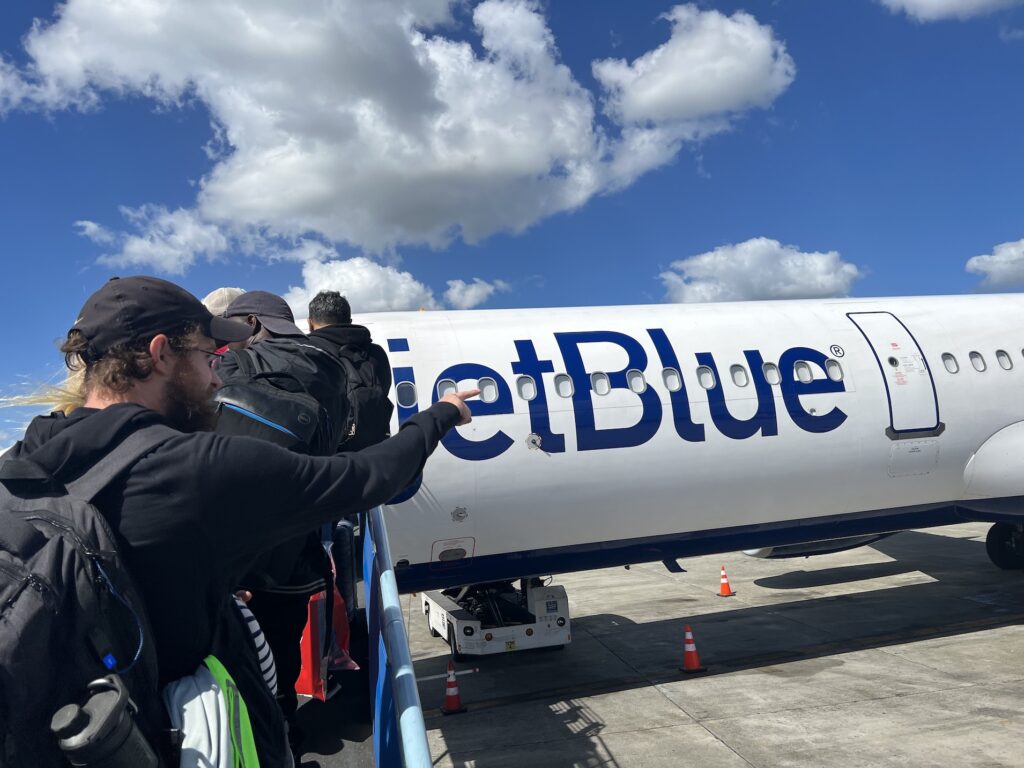
Where to stay in Santo Domingo
We recommend staying in Zona Colonial. This is where most of the sites and museums are located and it has the densest concentration of hotels, bars, restaurants and other amenities. For a quick reference point, that’s going to include the area between Independence Park, Plaza de la Hispanidad and the water.
We personally stayed at Casas del XVI, which is one of the more luxurious accommodations in the area. While we enjoyed our stay at this hotel, we definitely had a few complaints, so we can’t say it was necessarily worth the splurge.
For a look at some other hotel and accommodation options, we found this guide really helpful.
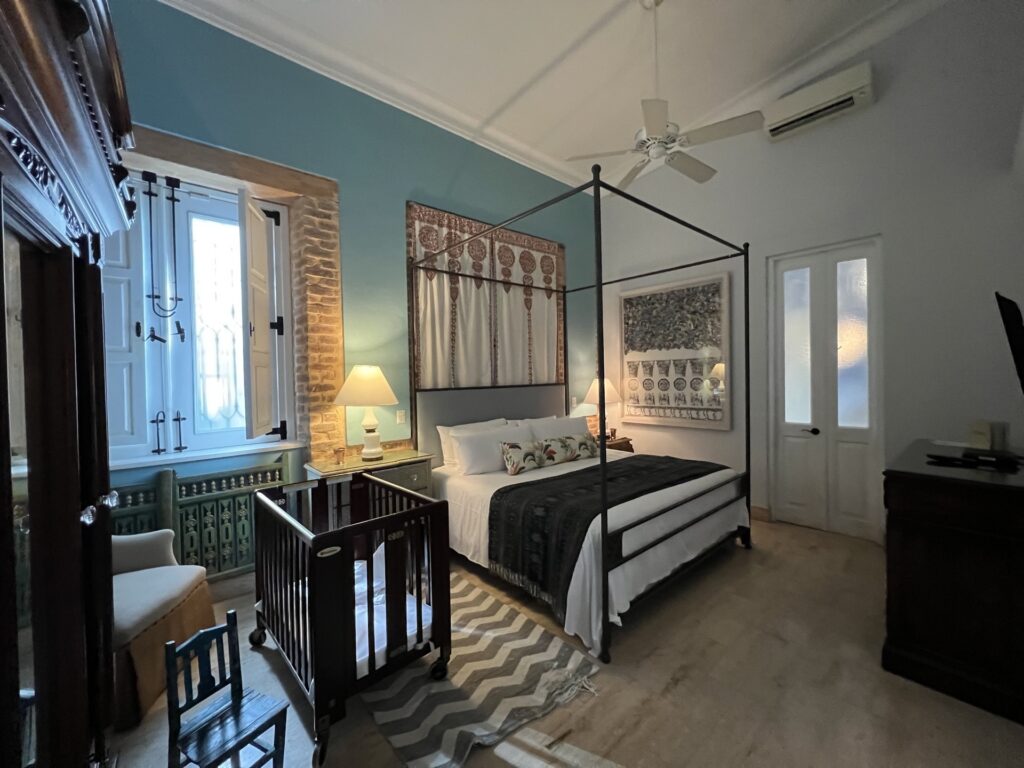
How long to stay in Santo Domingo
Two full days is the perfect amount of time to spend in Santo Domingo. Zona Colonial has a lot of little things to do, so you can actually fit in a lot over a short period of time. With two full days, plus travel days on either side, we were able to see and do everything we wanted to.
If you’re traveling from fairly close by (flight times under 4 hours or so), Santo Domingo is a great option for a long weekend. If you have more time or are traveling from a further distance, we suggest pairing a few days in Santo Domingo with a few days at a resort. Punta Cana is a popular Dominican option. If you were flying anyway, though, you may want to consider Puerto Rico or Jamaica, too.
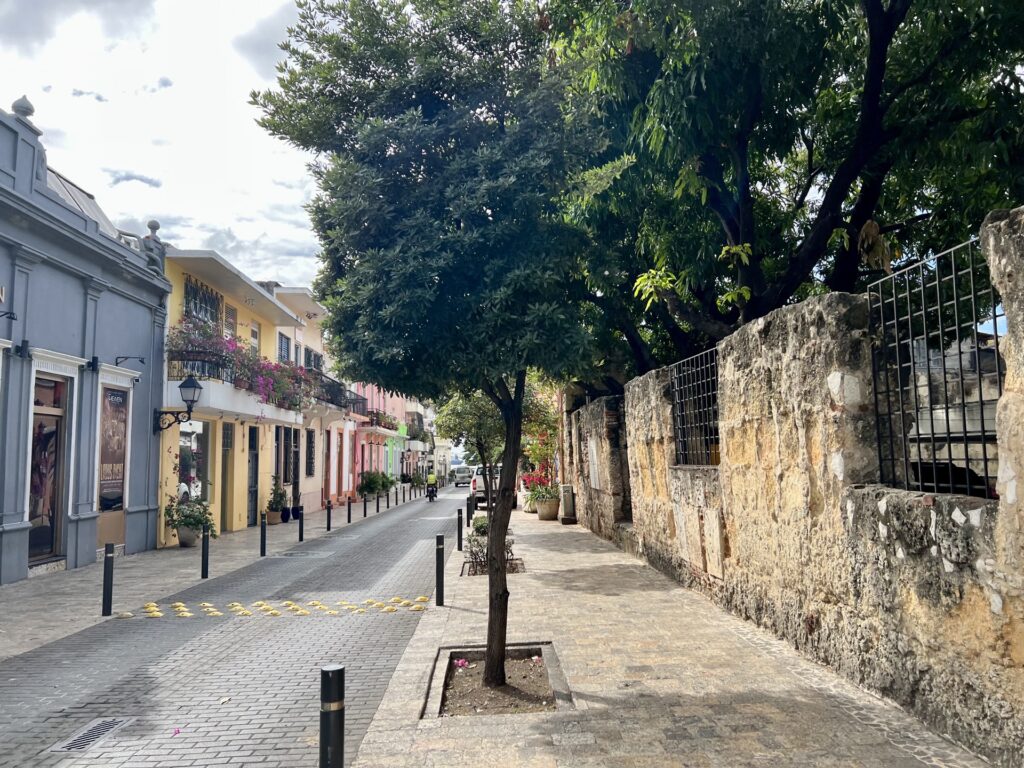
When to go to Santo Domingo
Santo Domingo has a tropical climate, meaning it’s warm and sunny most of the year. Temperatures typically hover around the 70s and 80s F, with summers being slightly warmer and rainier.
The Dominican Republic as a whole is hurricane prone, but Santo Domingo specifically is rarely directly hit. Hurricane season falls between June and October, with the risk peaking in late August and early September.
The most popular tourism season in Santo Domingo is between November to March. That also aligns with winter in the northern hemisphere, which has people itching for a Caribbean getaway.
So when should you go to Santo Domingo? We’d recommend visiting in January or February. It is peak tourism season, but the crowds aren’t really an issue. If anything, the higher crowds will add to the experience. If you’re looking to save money on your hotel stay though, consider shoulder season in April/May or October/November.
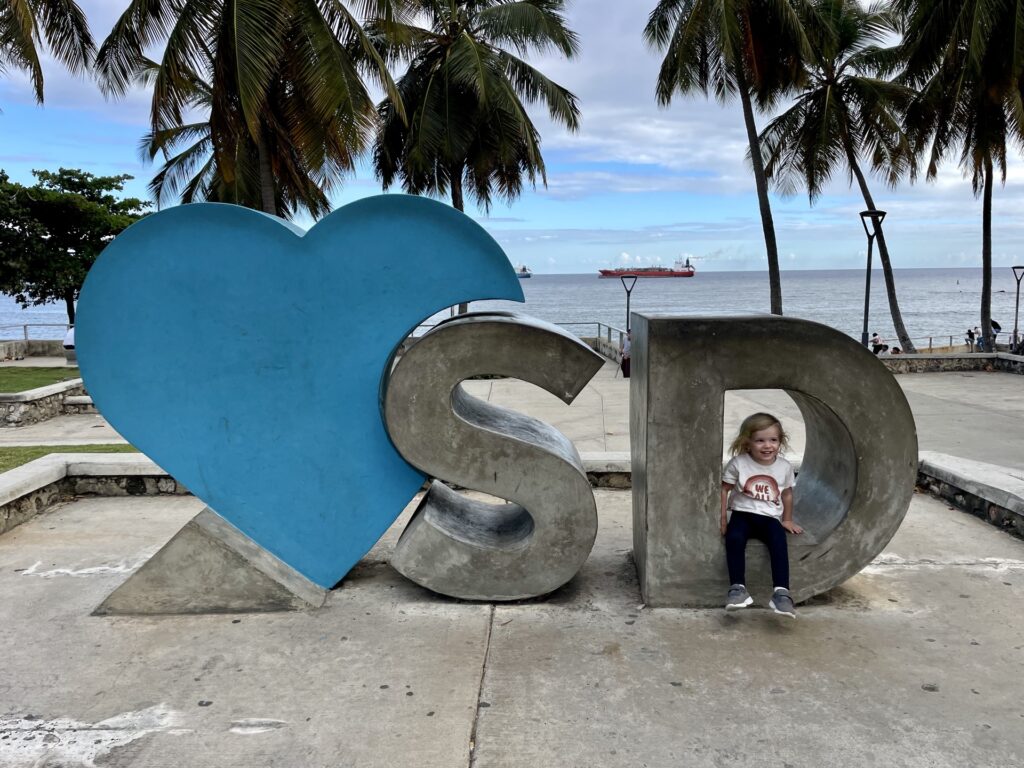
Getting to Zona Colonial from the airport
To get from the airport to Zona Colonial (or anywhere in Santo Domingo), take an Uber. When we arrived midday, Uber prices were around $20 USD (DOP 1,162 for an UberX and 1,819 for an UberXL).
Taxis are also available, but are usually more expensive. There is no public transportation (buses or trains) at Las Américas International Airport.
Alternatively, you can schedule a shuttle service. The easiest way to do that is to work with your hotel directly. They will be able to coordinate and translate, and then they can be your point of contact if you run into any issues.
If you’re visiting Santo Domingo with kids, you may need to plan for car seats. If you are traveling with your own car seat, installing it in an Uber is the easiest and cheapest option. Alternatively, car seats are not required in the Dominican Republic, so you could technically go without one.
We personally didn’t feel comfortable with that, but we also prefer not to travel with a car seat. That ruled out Uber and taxis for us. Instead, we worked with our hotel to have a driver pick us up in a vehicle with a car seat. It was much more expensive, but the easiest option for us.
Getting around Santo Domingo
Once you’ve arrived in Zona Colonial, the main sites are all walkable. Nothing in Zona Colonial will be more than a mile away. The attractions are all centrally located and close to one another.
If you’re traveling outside of Zona Colonial, use Uber.
Again, unless you’re traveling with kids and require a car seat. You can still install your own car seat in an Uber, but then you’ll be stuck carrying the car seat at your destination. For transit around the city, it’ll be easiest (but unfortunately more expensive) to work with your hotel to schedule a car service with a car seat.

Things to do in Santo Domingo (Zona Colonial)
Santo Domingo is a large city that sprawls far beyond the city walls of Zona Colonial. While there is a lot to do in the city, this section and our sample itinerary focuses primarily on Zona Colonial. We assume most tourists will be keeping to this general area, so here’s some of the best things to do there.
Museums & Historical Sites:
- Alcázar de Colón (Columbus Alcazar): This palace built for Diego Columbus (the son of Christopher Columbus) is the oldest European palace in the Americas. The palace is now the most visited museum in Santo Domingo. There are no posted signs, but audio guides in a variety of languages are included in the price. Closed on Mondays.
- Fortaleza Ozama (Ozama Fortress): Preserved castle-like fort and city walls from the 16th century which you can explore inside and out. Signs were posted in English and Spanish, and audio guides were available. Closed on Mondays.
- Museo de las Casas Reales (Museum of the Royal Houses): Dominican Republic history museum inside a 16th century palace. The building was once the Palace of the Viceroy of Santo Domingo and was Spain’s first government building in the Americas.
- Nuestra Señora de la Encarnación (The Cathedral of Santa María): The first and oldest cathedral in the Americas. It’s open to the public everyday except Sunday.
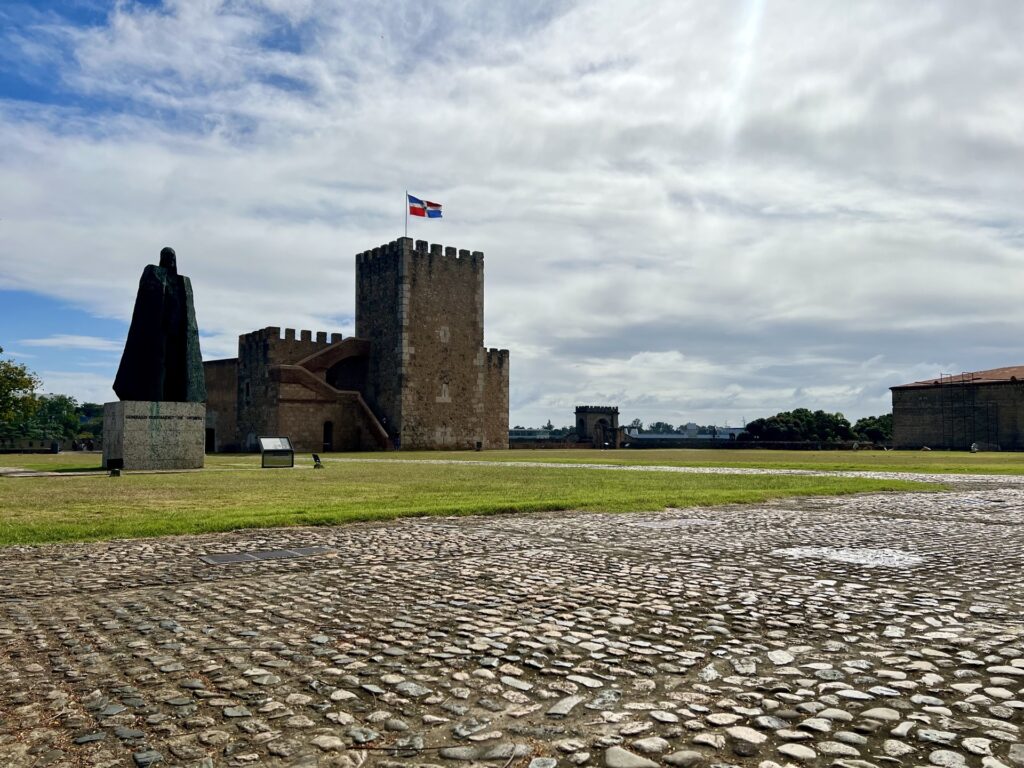
Squares & Walks:
- Plaza de la Hispanidad: The main square and heart of Zona Colonial in front of Alcázar de Colón. Popular place for people watching, enjoying an overpriced touristy meal and city events.
- Parque Colón (Columbus Park): Lively square near the cathedral. It’s a popular place for people to hang out and children to play. It’s busy at all types of day, but it really shines in the early evening.
- Calle El Conde: Pedestrian street with quick-service restaurants, shops, and street vendors. It really gets going in the evening and on weekends.
- Waterfront Path: Paved oceanfront walking path that extends from Monument to Friar Antonio of Montesino to Plaza Juan Barón. There are a couple restaurants, several monuments, and lots of seating and green space.
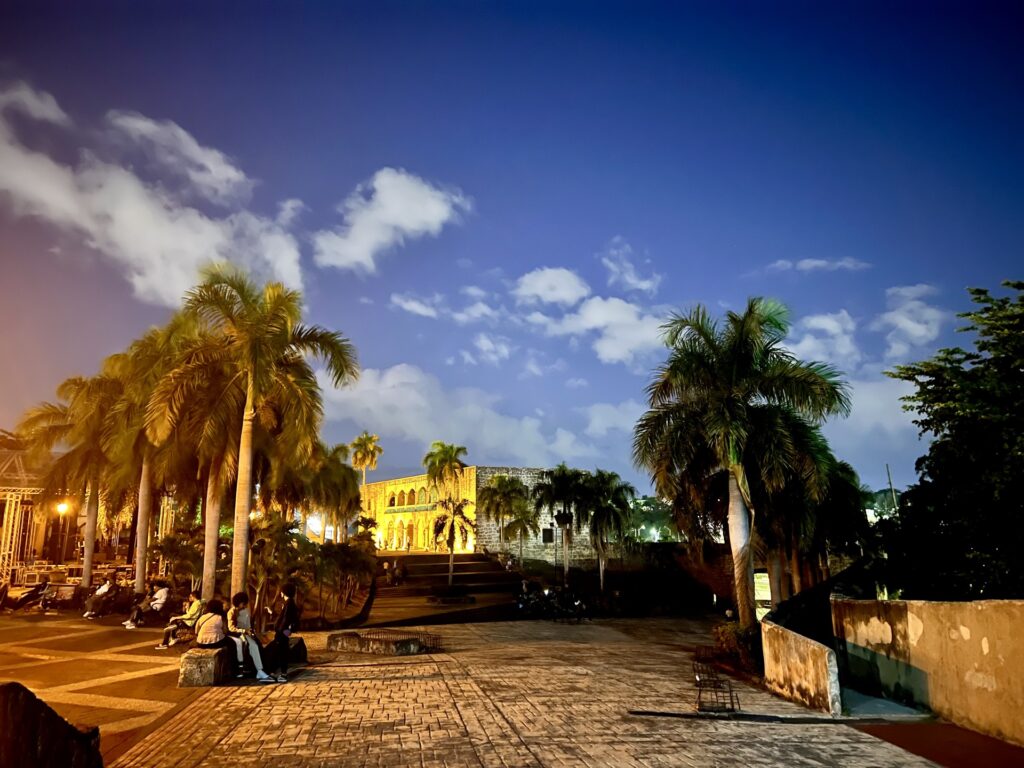
And a few other things ….
- Los Tres Ojos National Park: Open-air cave with three crystal clear blue lakes. The caves are located about 4 miles from Zona Colonial, so you’ll need a car (Uber or car service) to get there. We also have a full guide to Los Tres Ojos here.
- Plaza Juan Barón (Olimpyc Park): Small amusement park with a few rides, quick-service food stands and carnival games. I wouldn’t go out of my way to come here, but it was a hit with our theme-park loving 2-year-old, so you do what you gotta do to get through sometimes.
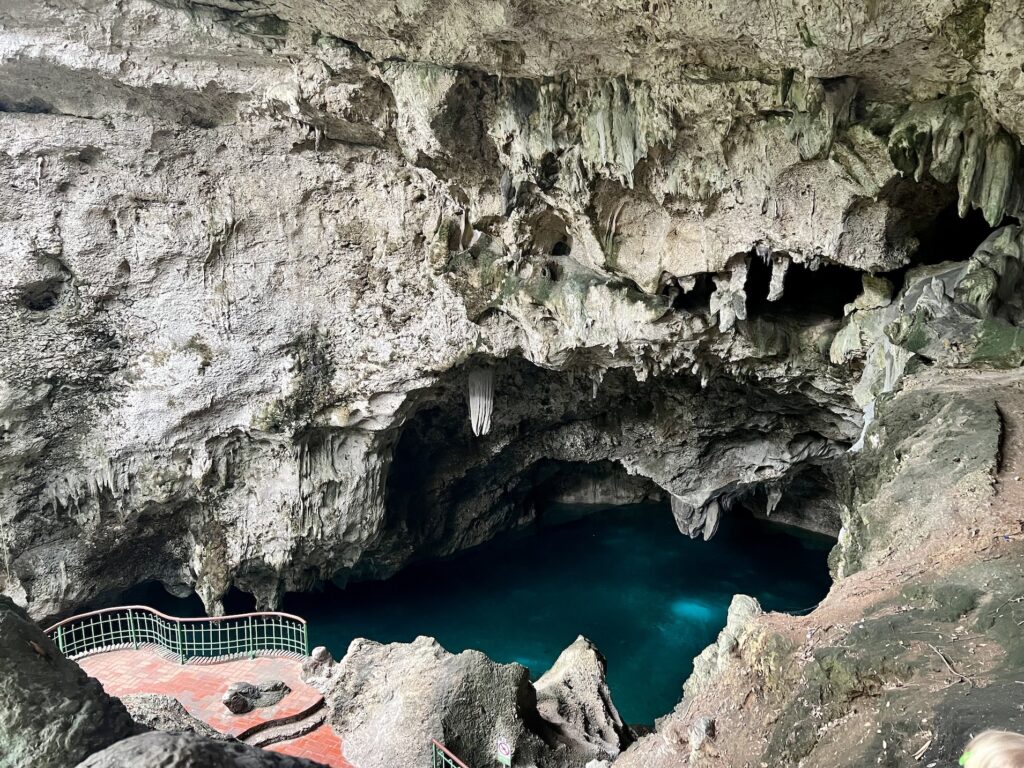
Complete 2-day Santo Domingo Itinerary
Two full days in Santo Domingo is the perfect amount of time to explore Zona Colonial. It will give you time to see some of the most important historical sites at a reasonable pace. This itinerary outlines how we’d recommend filling two full days, assuming you will have travel days on either side.
Arrival Day: Get Acquainted
By the time you land at Las Américas International Airport, transit to Zona Colonial and check into your hotel, there’s a good chance it will be late afternoon or early evening at best.
If you’re ready to hit the ground running, we suggest heading out to Plaza de la Hispanida. It’s a great place to start your trip, especially if it also involves a short walk through Zona Colonial to get there.
Relax, take in the energy of the square, and enjoy a Presidente (local Dominican pilsner). There’s a handful of restaurants along the square. They are all touristy and overpriced, yes, but we say just do it on your first night. It’s an easy meal option in the heart of the old town. We personally ate at Morrofino Bar de tapas.
Alternatively, if you get in late or are just zonked, enjoy the evening at your hotel — especially if it’s a nice one.
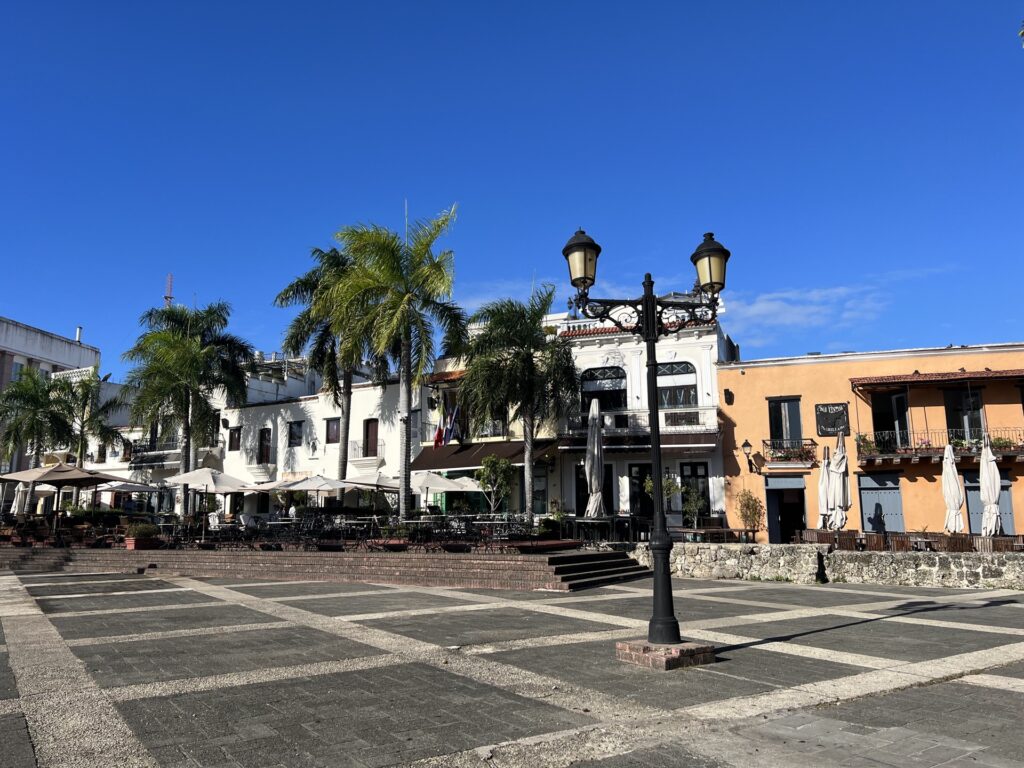
Day 1: Caves & Old Town Sites
We recommend starting your trip with a visit to Tres Ojos on your first morning. While it’s hard to leave Zona Colonial when you feel like you just got there, it’s a good idea to try this activity on your first day. That way, if the weather happens to be bad or if you run into issues, you still have another day to try again.
Not all 2-day trips will be on a weekend, but we know a lot of them will be. For that reason, we prioritized the Cathedral on the first day (assuming there’s a good chance that’s a Saturday) because it’s closed on Sundays.
Okay, let’s get started.
Breakfast & Coffee at Casa Barista & Co.
This trendy coffee shop and cafe is located just steps away from Parque Colón. They have an entirely gluten-free menu, but I wouldn’t have noticed as a gluten-eater. They have a solid breakfast and lunch menu, as well as a pretty extensive coffee menu.
We ended up here twice during our visit and would personally recommend the Coffee Tonic and dark chocolate pancakes. Our toddler would also like to recommend the Babyccino (unsweetened hot cocoa in a demitasse) and the Fresa Limonada(strawberry lemonade) to fellow baby travelers.
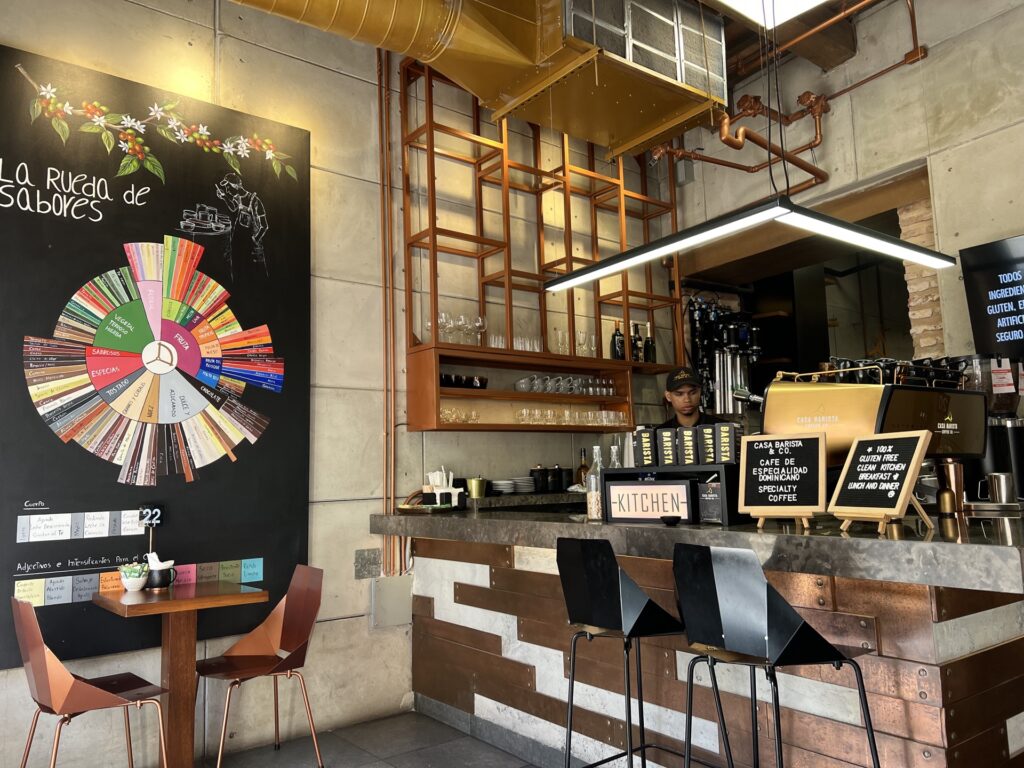
Lago Los Tres Ojos (The Three Eyes)
Tres Ojos is an open air cave with three crystal clear cave lakes, or eyes. After you go down the winding stairs into the caves, you can follow a handful of paths with different views of each of the three lakes. For a few extra pesos, you can take a small boat across the third eye for an incredible view of a fourth lake (not technically a cave lake so it’s not counted as one of the three eyes).
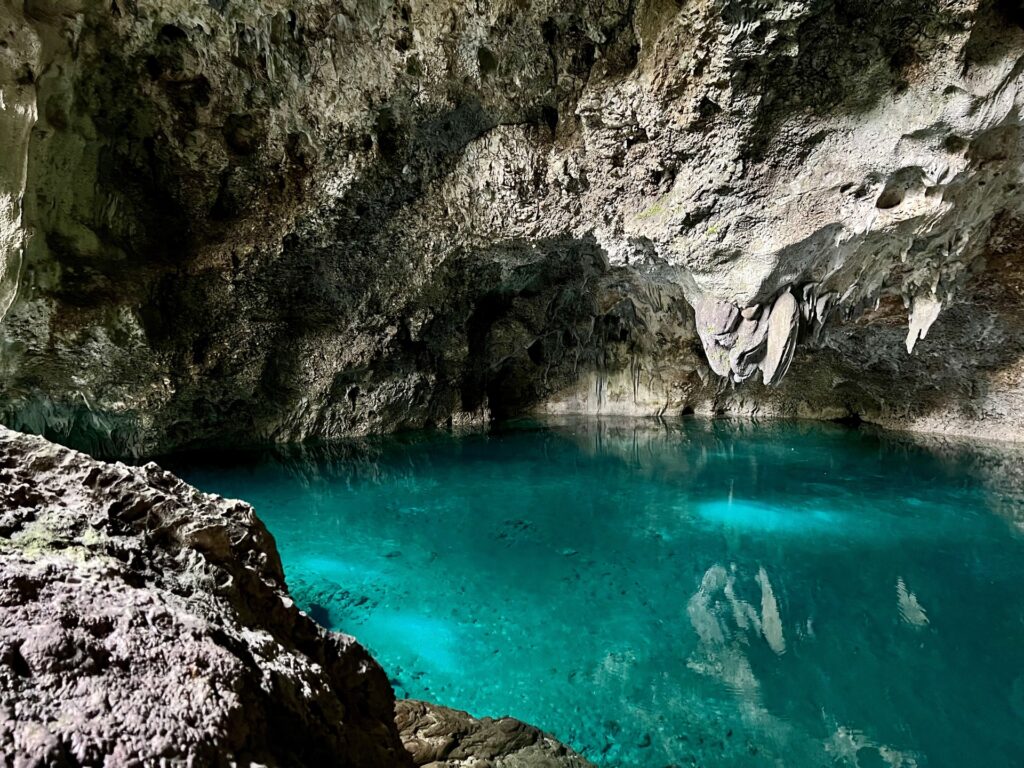
It’s an incredibly beautiful and unique nature reserve that is surprisingly easy to experience. There is no hiking required, but it does require a lot of stairs. They’re well-maintained, but you’ll still want shoes with decent traction.
By the way, don’t let the term “cave” scare you. While that’s technically what it us, it feels more like taking stairs down into an outdoor basement. You will always be able to see the daylight and it’s not claustrophobic at all. If you take the boat to the fourth eye, you will walk through an underground cave, but it’s very short and you’re right back outside.

- Price: 200 DOP (~ $3.50 USD) + 50 DOP (~ $1 USD) for the optional boat ride to the 4th lake
- Hours: 8 AM to 5 PM every day
- How long does it take: 2 hours
- How to get there: Take an Uber for about $4 USD
- Tip: Arrive early to beat the tour groups. Also bring extra cash for drinks and snacks at the cafe.
Lunch near your hotel
If you’re taking an Uber from Tres Ojos, you’ll probably want to have them drop you off at your hotel. Odds are you’ll be sweaty and want to freshen up a bit, but you’ll also be pretty hungry. This is a good time to grab a quick and easy meal nearby.
We personally got lunch at our hotel, which we loved for its convenience. If your hotel doesn’t have a restaurant (or one that interests you), head back out into town. Maybe grab a quick slice of pizza at Curcio Pizza al Taglio or enjoy the beautiful atmosphere of Buche Perico.
Nuestra Señora de la Encarnación (The Cathedral of Santa María)
After you’ve refueled, it’s time to see some of the historical sites in town. The Cathedral of Santa María is located right beside Parque Colón. This church is famous for being the first and oldest cathedral in the Americas. It was built in the 1500s in the Gothic style.
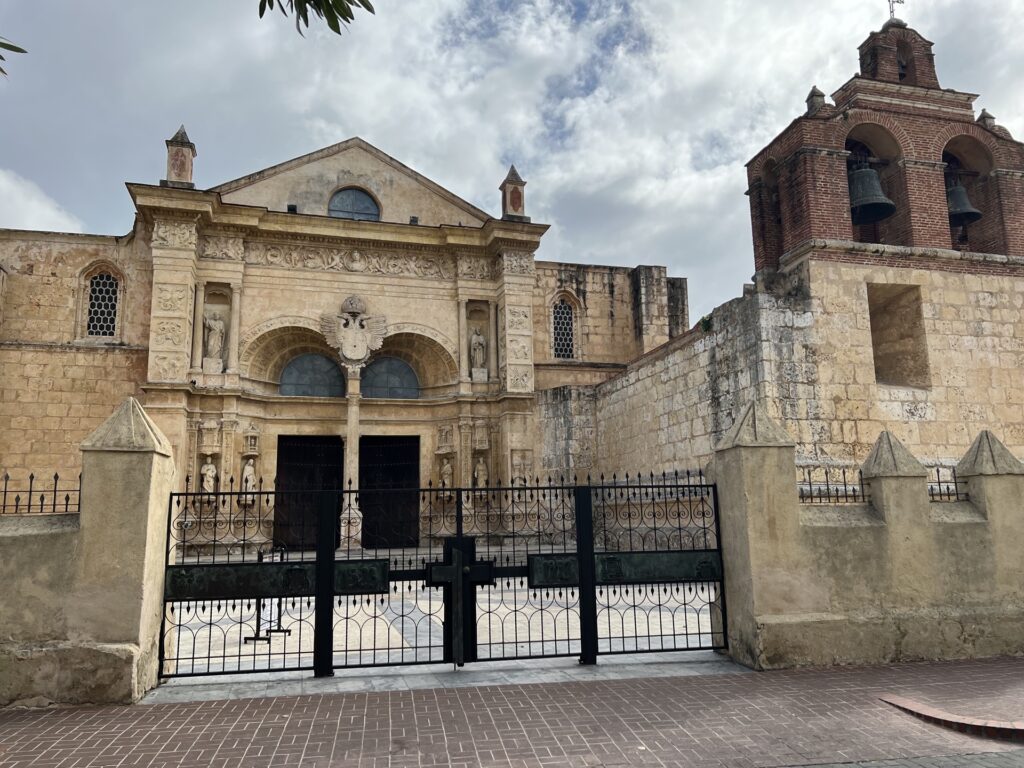
The entrance to the cathedral is on back side of the church (east side).
- Price: Free
- Hours: Monday through Saturday 9 AM to 4 PM. Closed to the public on Sundays.
- How long does it take: 30 minutes
Museo de las Casas Reales (Museum of the Royal Houses)
This museum is built inside a Spanish government building from the 1500s. Wandering through the historical building is worth the small entry fee alone. Inside though, you’ll also find a variety of authentic objects and replicas that span the Dominican Republic’s history from colonialization to present.
Most of the signage is in Spanish, but audio guides are available in a variety of languages and are included in the ticket price.
- Price: 100 DOP (~ $2 USD)
- Hours: Tuesday through Sunday 10 AM to 6 PM. Closed on Mondays.
- How long does it take: 1 hour
Dinner at Time Creative Vegetarian Kitchen
We are vegetarians, so of course this restaurant stood out to us. However, it was honestly so good that we would recommend it to everyone regardless of their meat preferences. Not only was the food incredible, but they had a delicious cocktail menu too. (Notably no beer though.)
There’s a lot of variety on the menu, but I cannot stop thinking about the arepa de choclo. I also got their version of a spicy/smoky margarita which was also incredible.
Enjoy the atmosphere at Parque Colón
After dinner, take a stroll around Parque Colón. The square is always lively, but really gets going in the early evening and during weekends. There’s kids chasing pigeons, people dining al fresco in the nearby restaurants, and street musicians playing guitar.
If you’re in the market for something sweet, pick up a paleta at Paletas Bajo Cero or a crepe from Zona Creps and enjoy it in the square.
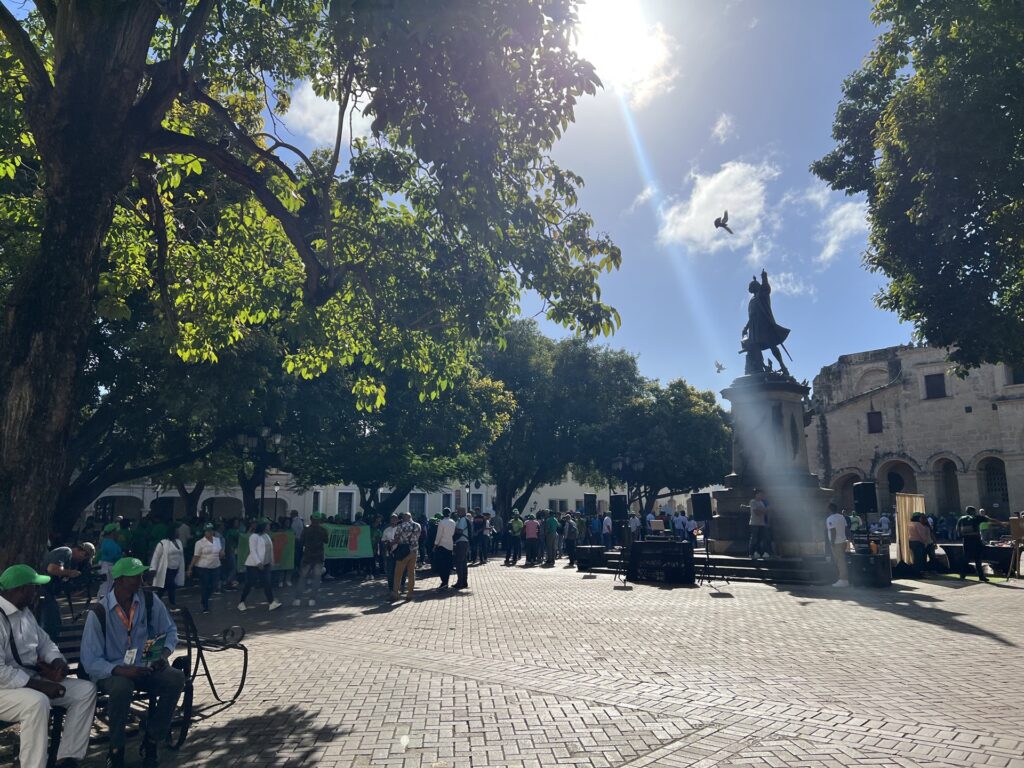
Night cap at SugarCane
Wrap up your day with a cocktail at this chic rooftop bar. They have a deep cocktail menu, specifically focusing on rum-based drinks.
We personally didn’t make it here (because #toddler), but it looked beautiful, has great reviews, and always looked fun when we walked past it.
Day 2: Old Town Sites & Water front
Today’s itinerary starts with some of the most popular historic sites in Santo Domingo. Then in the afternoon you’ll have a chance to venture out and enjoy some different views along the waterfront. This itinerary doesn’t pack in too much, so you have some time to wander. See a cute street? Head down it for a bit. Interested in picking up a souvenir? Stop in any of the shops you’re sure to walk by.
Enjoy taking in the sites and sounds of Zona Colonial on your last full day.
Breakfast & coffee at Affogato Café
Guess what? You’re on vacation, so if you want to start your day with ice cream in your coffee, this is the place to do it! But don’t worry, you won’t have to. This cute cafe is a popular spot and they offer a full menu of sweet and savory items.
The namesake affogato comes with espresso, a shot of whiskey and a pretty big ice cream sundae. Or you can go with a more basic espresso or coffee beverage. We enjoyed the strawberry crepes (though they also came with ice cream) and strawberry stuffed french. Our favorite thing though, and I know it’s not breakfast, was the pesto pasta.
This cafe is closed on Tuesdays.
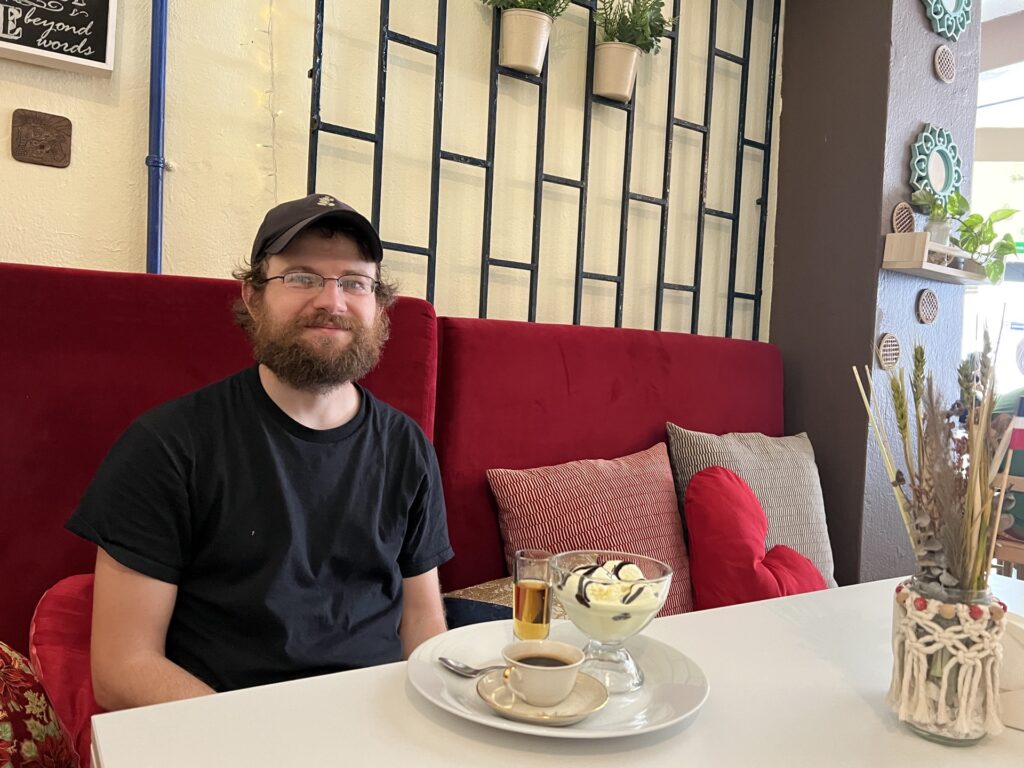
Alcázar de Colón (Columbus Alcazar)
Next up is the most popular museum in all of Santo Domingo. This small museum is set inside of the palace built by Diego Columbus, the son of Christopher Columbus. It’s the oldest European palace in the Americas and the only known residence of any family members of Christopher Columbus. While the palace itself was built in the early 1500s, most of the objects inside are not from that time period.
There are no signs posted inside the museum. Instead, audio guides are available in a variety of languages and are included in the price of admission. I loved that the audio segments were short – only about 40 seconds for each location.

The museum is located on the main square, Plaza de la Hispanidad. It’s a popular photo spot for tourists and locals alike, particularly at night.
After the museum, you can also check out Fuerte el Invencible, and walk along a portion of the old city walls. (However, I will say that it was kind of gross up there. It smelled like pee and was full of beer bottles. But still I’m glad we did it!)
- Price: 100 DOP (~ $2 USD)
- Hours: Tuesday through Sunday 10 AM to 6 PM. Closed on Mondays
- How long does it take: 1 hour
Fortaleza Ozama (Ozama Fortress)
After leaving Plaza de la Hispanidad, take a short stroll down Las Damas on your way to the fortress. This notable street has a few historical sites along the way, most notably the National Pantheon.
After a few blocks you’ll arrive at the Ozama Fortress. You can explore the castle-like fortress, visiting different rooms and passages along the way. In addition to the fortress itself, you can also walk along another preserved section of the city walls and rows of replica cannons.
Audio guides were available and included in the ticket price. However, all of the posted signs were in English and Spanish, so you might not need them.
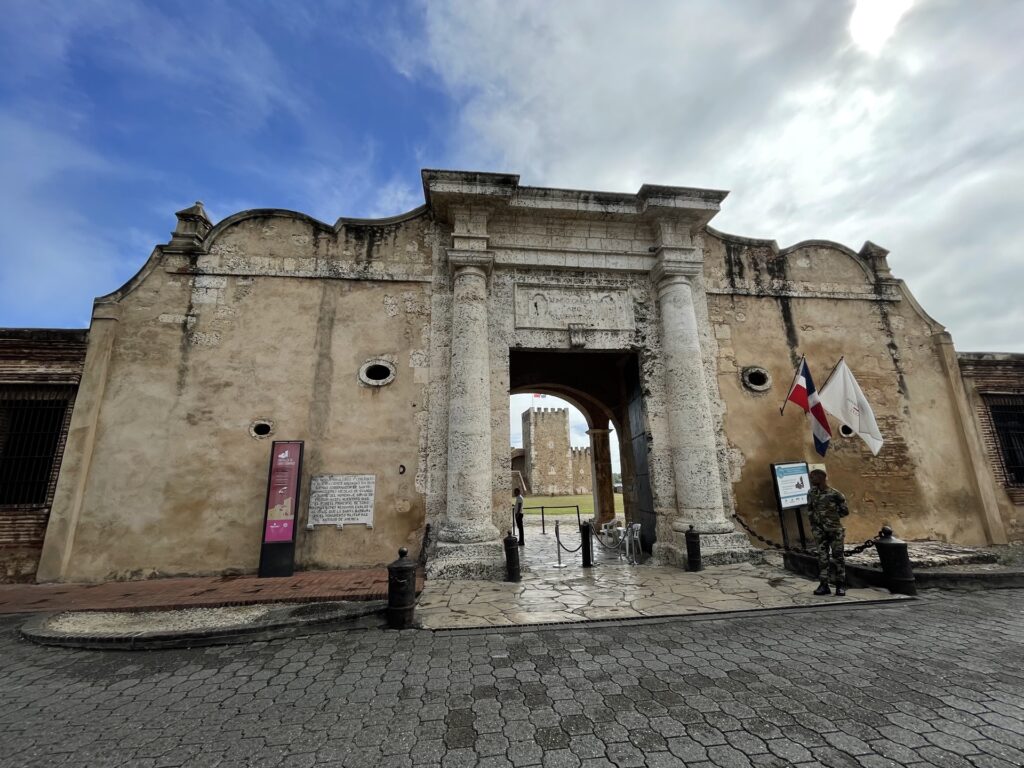
Ozama Fortress was one of our favorite things in Santo Domingo. It was not crowded and pretty spacious, and we really enjoyed taking our time here.
- Price: 70 DOP (~ $1 USD)
- Hours: Tuesday through Sunday 10 AM to 6 PM. Closed on Mondays
- How long does it take: 1 hour
Lunch at El Buho Eatery
If you’re looking for a cute cafe with a wide variety of menu options, look no further. El Buho is a bit tucked away on a side street, but it happened to be really close to our hotel which is how we found it. They offer classic Dominican cuisine as well as a variety of western and international options.
Do note that they don’t open till noon most days and are closed on Mondays and Tuesdays.
Walk along the waterfront
For a change of scenery, head toward the ocean on the south side of Zona Colonial. There is a paved walking path that runs from Monument to Friar Antonio to Plaza Juan Barón. The walk offers great views of the ocean and rocky coastline. The pathway is dotted with monuments, with a few restaurants and outdoor seating areas. (I do NOT recommend sitting on the grass. I swear I can still feel the ant bites.)
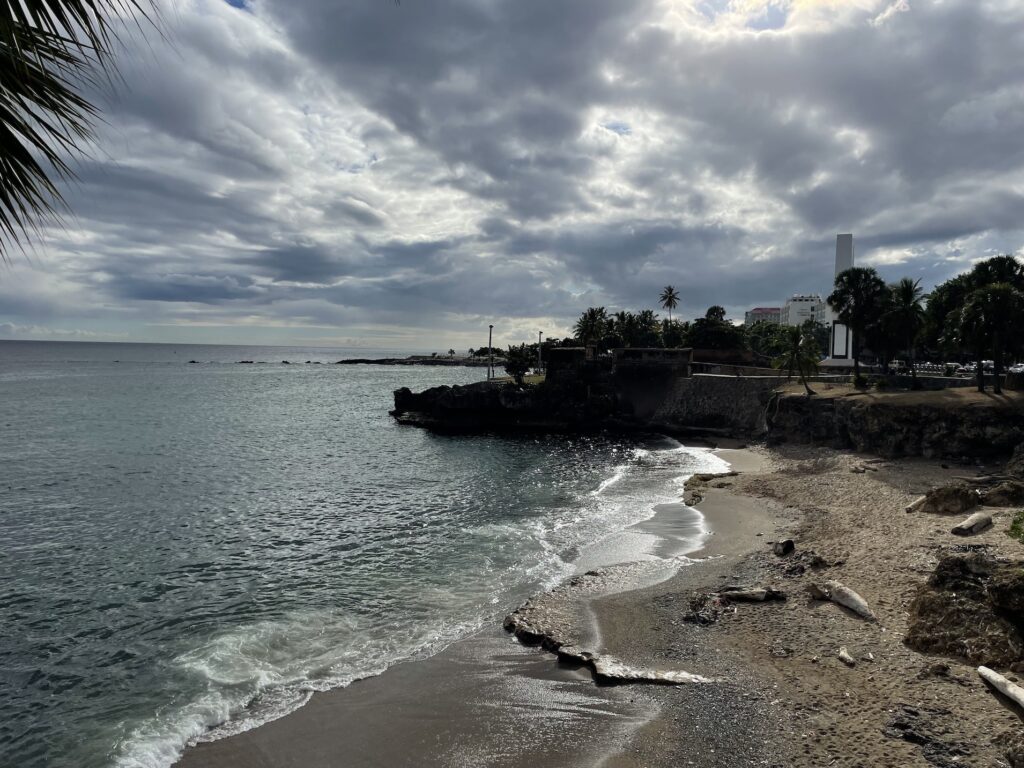
The path is about 1 km and takes about 15 minutes from start to finish. At Plaza Juan Barón at the end, there is a small amusement park called Olimpyc Park. It’s really just a crappy carnival, but our theme-park loving two-year-old had the very best time there. I wouldn’t recommend it for adults, but it’s a fun thing for kids if you’re traveling with little ones.
Calle El Conde
Instead of walking back down the waterfront to where you started, head straight north from Plaza Juan Barón to Independence Park. This marks the start of Calle El Conde, a popular pedestrian street that runs all the way to Parque Colón.
This street is lined with shops (mostly souvenir shops and street art vendors) and restaurants (mostly quick service). It’s often quite busy, but it really got going in the evening.
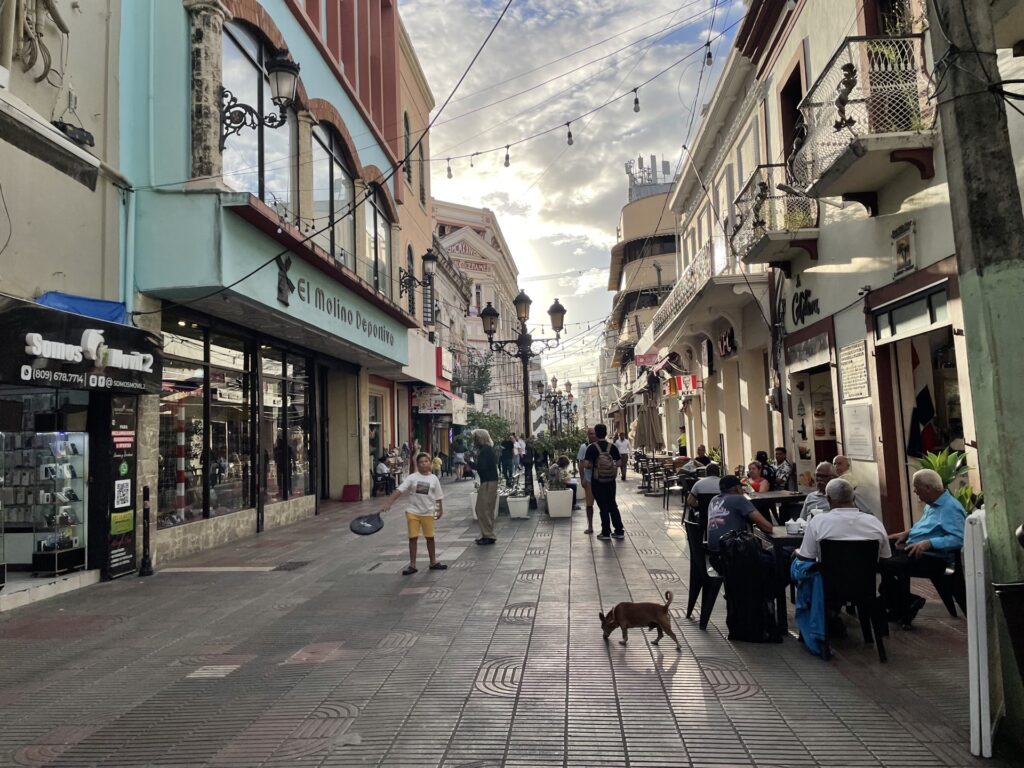
Dinner at MIX Empanadas
While you’re walking down El Conde, stop for dinner at MIX Empanadas. This place was very popular and very delicious. They had a wide variety of empanadas available, including several vegetarian and vegan options. Their juices were also very popular and came in a variety of flavors (one of which was called cerveza but was very much not beer).
The empanadas are pretty big and most people ordered two per person. We got seven for two adults and a child, and it was definitely too much.
Parque Colón and/or Plaza de la Hispanidad
El Conde will end (more or less) at Parque Colón. We really loved the squares (both Parque Colón and Plaza de la Hispanidad) and tried to swing by them each night. If you’re not in a hurry, stroll through both.
If you didn’t get a paleta last night, get one tonight. The coconut with dulce de leche filling was truly what dreams are made of.
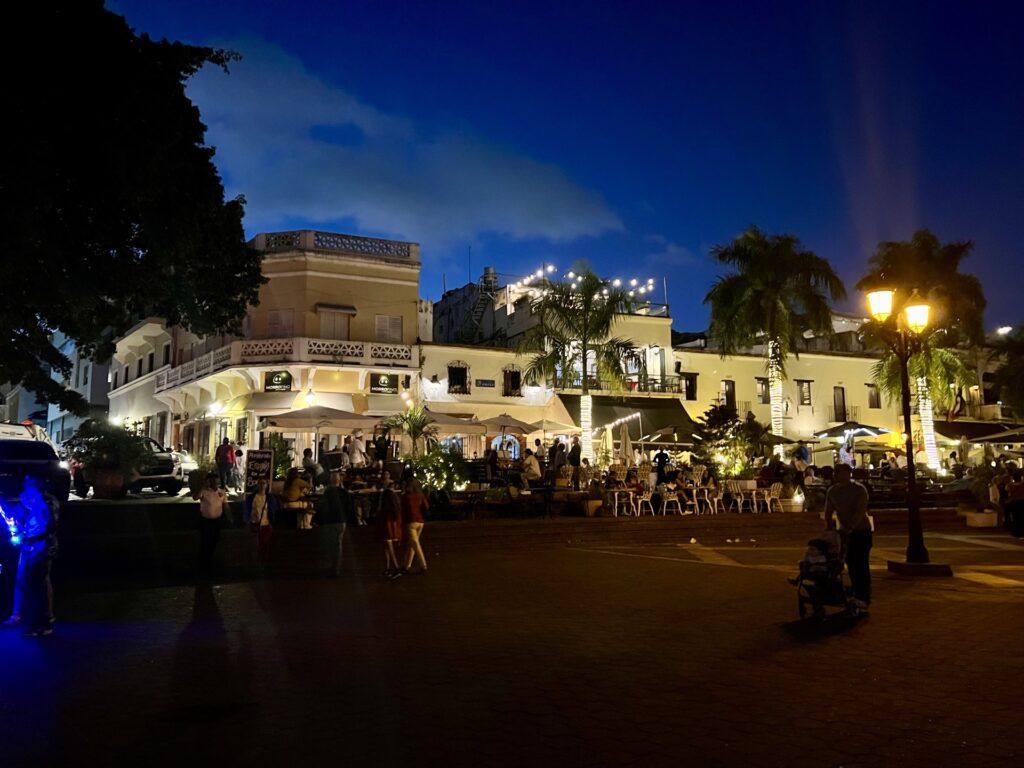
Craft beers at Republica Brewing Draft Room or La Cacata Brewing
Close out your visit with beers one of the two main beer bars in Zona Colonial. Republica Brewing will have the best beer selection, while La Cacata has a more relaxed beer garden vibe.
Departure Day
Depending on when you depart, you may have time for one final stroll through the old town. We had a few hours on our final morning and got another round of coffees at Barista & Co. and then wandered the squares.
We had planned to visit the cathedral — which should have been open on a Monday morning — but it was closed for a local holiday. That’s a good reminder to never save things for the last day of your trip.
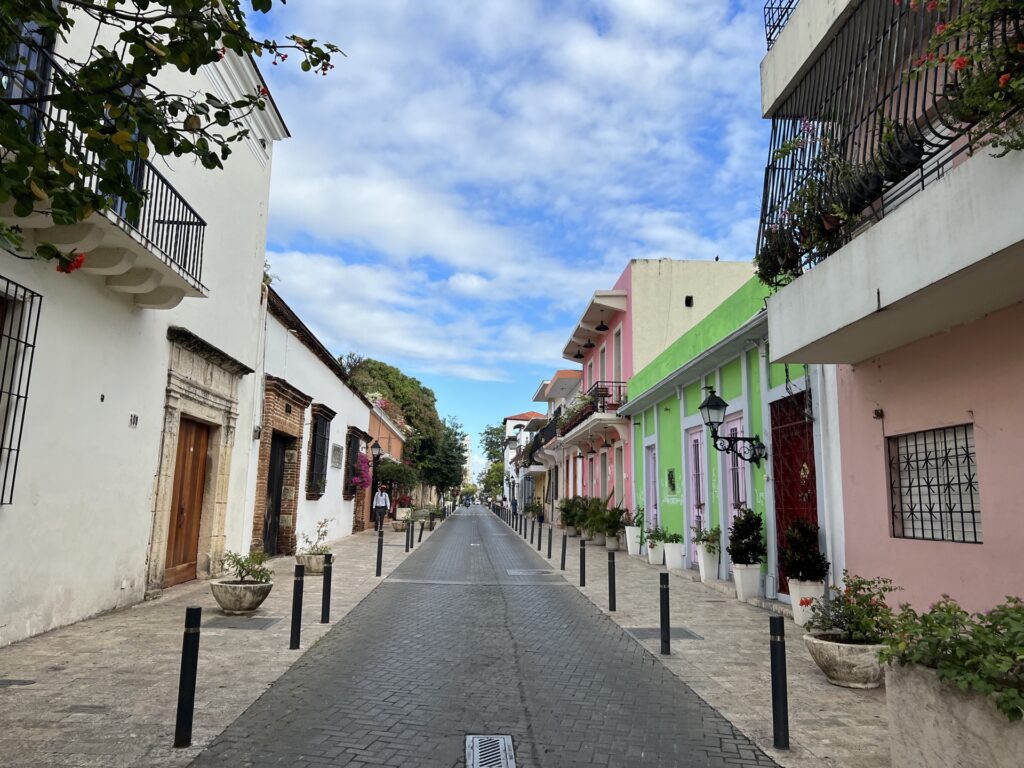
Closing Thoughts on Santo Domingo
We loved our visit to Santo Domingo. It had a good mix of history, energy and grit — all things we love about a city. It was a perfect destination for a long weekend and a great escape from New York City in the winter.
There’s enough to do to keep you busy, but not so much that you need to stress about it. Zona Colonial covers a small area, and I liked that I could just meander without a plan. Not many things require advance planning and you don’t really have to worry about heavy crowds impacting your trip.
We’d definitely recommend Santo Domingo as a short trip on its own or paired with a resort stay in Punta Cana or other nearby island.
